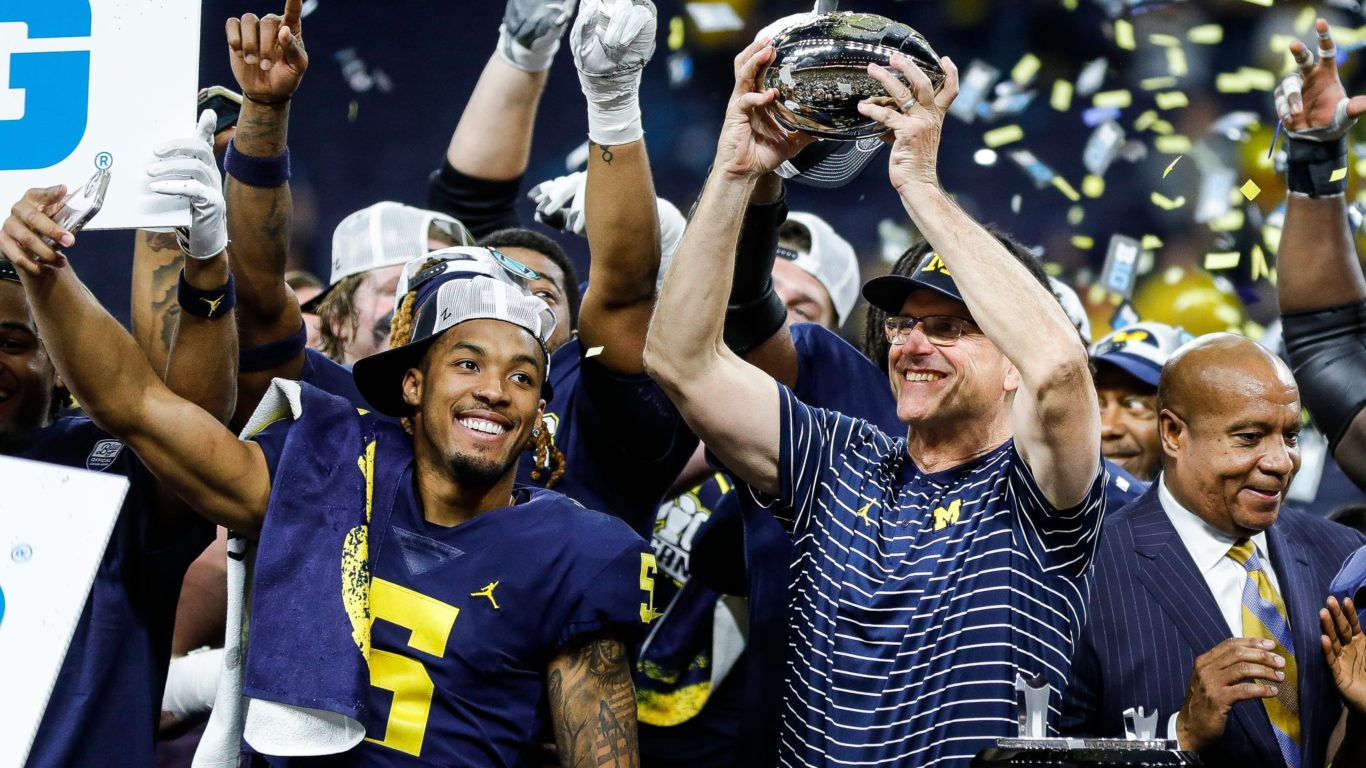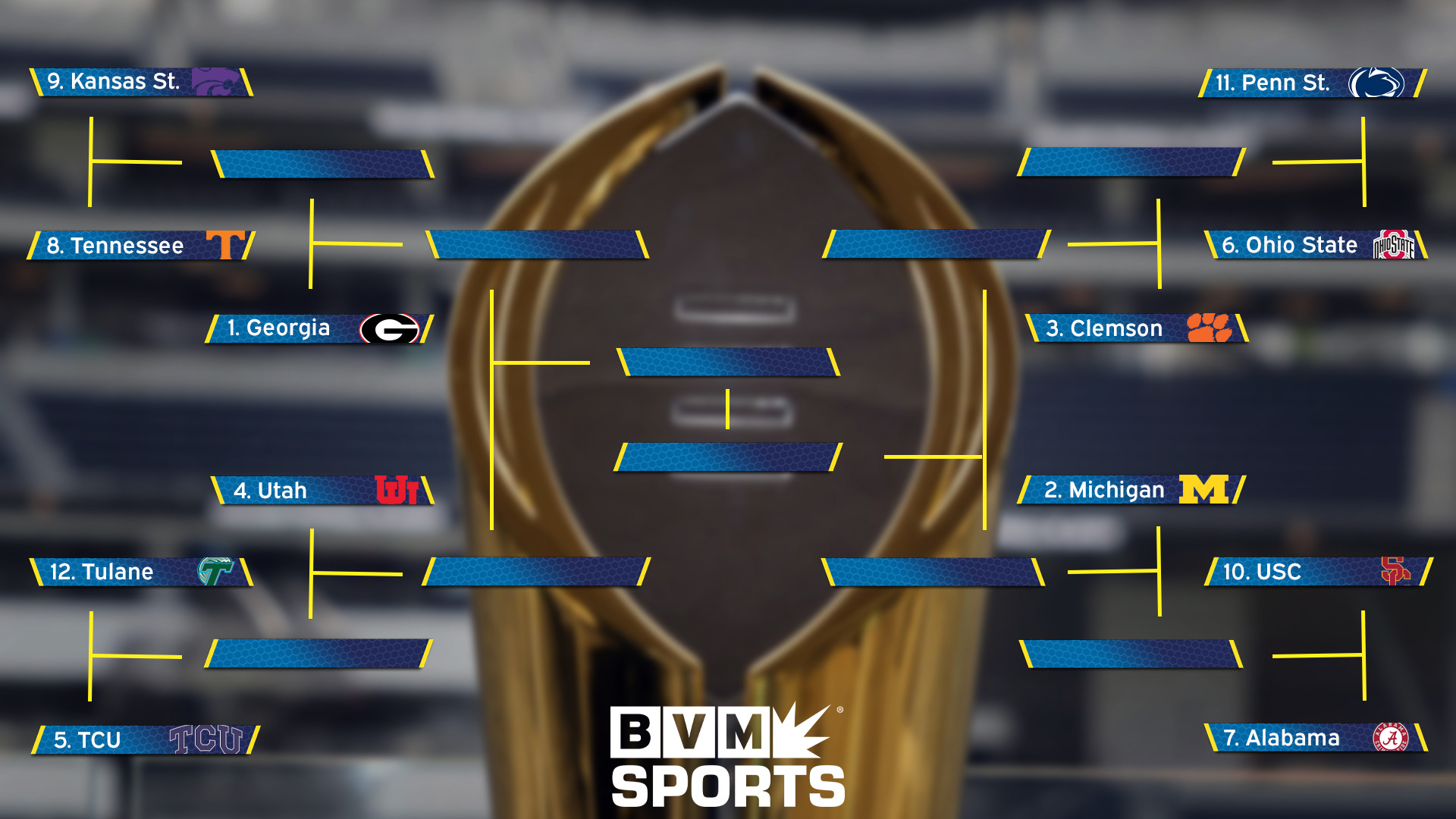
12-team CFP: More games, more controversy & same teams winning it all
(BVM) — Last week, it was announced that the College Football Playoff will expand to 12 teams for the 2024 season.
If you haven’t already seen a mock-up of what that 12-team model would look like with this season’s results… brace yourself. It’s probably not what you had in mind.
Obviously, a bracket with 12 teams can’t require everyone to win the same number of games to reach the final, so the format will give a first-round bye to each of the top four seeds. Fair enough.
The problem is going to be how they arrive at those four teams.
Over the past nine seasons, we’ve sometimes watched the selection committee struggle to select and seed the top four. This system is supposed to alleviate some of that controversy by requiring those premium slots to go to conference champions. But as you’ll see, it only creates a bigger mess.
The rationale behind this approach is not only to incentivize winning a conference title but also to ensure that teams that didn’t play a 13th regular-season game don’t get an additional week of rest by having a first-round bye on top of it.
Once again, this is logical. It sounds good. But the 2022 season did a great job of exposing the flaws in this plan.
New CFP format using 2022 selection committee rankings

If that format was in place right now, the top two seeds would be the same as they are with the four-team model: Georgia and Michigan. But because of the upsets in the Big 12 and Pac-12 championship games, the third and fourth seeds would become Clemson and Utah.
If you’ve watched the season play out, that sounds really messed up. And when you look at how the rest of the bracket fills out because of it, you’ll see that the wrong teams are being rewarded.
For top-seeded Georgia, there’s no issue. They beat Tennessee easily with Hendon Hooker. They’d have little concern about facing the Vols without him in a quarterfinal… or Kansas State for that matter. And projecting to the semifinal round, whether it’s Utah, TCU or Tulane, that’s an easier draw than what the Dawgs have in real life this year against Ohio State.
But for second-seeded Michigan, this doesn’t work out as well. Sure, there’s a possibility that USC could upset Alabama (first-round games are on the home fields of the higher seeds, so that would be played in Tuscaloosa). But if Bama prevails, now the Wolverines have to open against the committee’s fifth-best team in a quarterfinal matchup – and not at home in Ann Arbor in the cold but rather at a bowl site, likely one that’s closer to Alabama’s campus than Michigan’s. That’s the reward for an unbeaten season that was worthy of consideration for the No. 1 seed?
The team that actually gets the big break is Ohio State. The Buckeyes would get to host Penn State, a team they’d already beaten on the road, and then draw Clemson on a neutral field. And while the Tigers’ QB change might make them better than they looked for most of the regular season, we’re still talking about OSU being able to reach a semifinal from the 6 slot by beating two lower-ranked teams.
And while you could argue that, being the fourth-ranked team (although sixth-seeded) should allow them such a path to a semifinal, here’s the other advantage for the Buckeyes. By not being the 4 seed, they’re now on the opposite side of the bracket from Georgia instead of having to face the Bulldogs in a semifinal.
So, what is Michigan’s reward for having gone into Columbus and won in late November and then following it up with the Big Ten championship? It’s difficult to see how that helped their national championship hopes in this future playoff model.
Unfortunately, when you give the 3 and 4 seeds to teams that clearly aren’t worthy of being in those spots on the bracket, the trickle-down effect is that the top two seeds will sometimes face a better opponent in a quarterfinal than they will in a semifinal. And while that does increase the chances of an “upset” that would give this expanded football playoff more of a basketball tournament feel, let’s be honest: in football, that’s rarely going to be a “Cinderella.”
The teams seeded outside of the top four that will most often crash the semifinal party won’t be the ones with rosters full of plucky three-star recruits that America wants to embrace. They’ll be the Ohio States and Alabamas that may have underachieved in the regular season but still have as much talent as anyone in the country and now have new life in the expanded playoff.
So, enjoy the opportunity for a Tulane or Kansas State to win a playoff game… or for a Utah to reach a semifinal. But when all is said and done, this new model is likely to give us more of what most fans don’t want to see: two SEC teams in the semifinals.
Football is not basketball. One or two players can’t get hot and take over a game. And while one elite QB can certainly turn the tables, it’s usually about the quality of the best 50 or so players on the roster. That means the advantage will continue to be with the teams that consistently recruit at a top-10 level.
Those are the teams you’ve gotten used to seeing in the four-team playoff over and over and over again. If anything, this new 12-team model will allow them to thrive even more.






